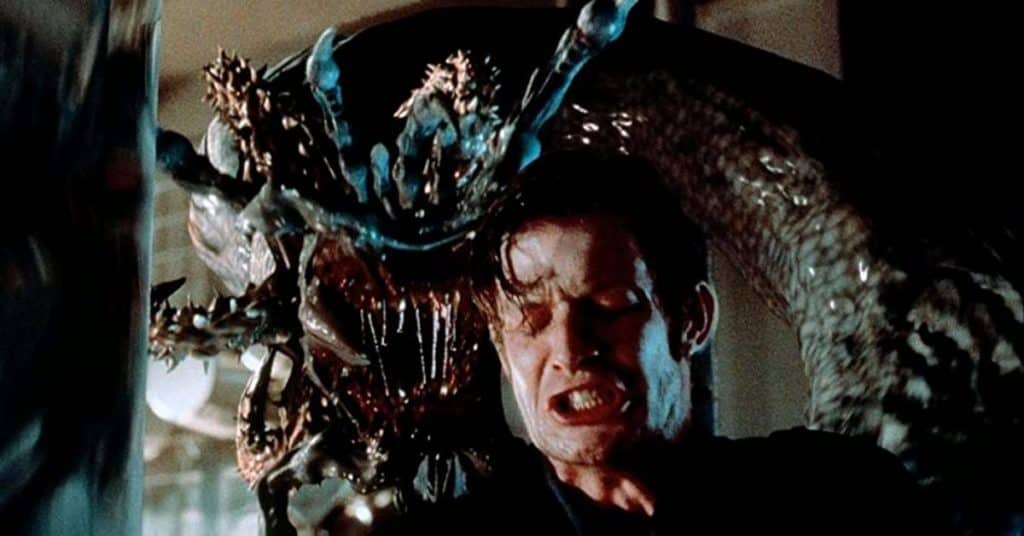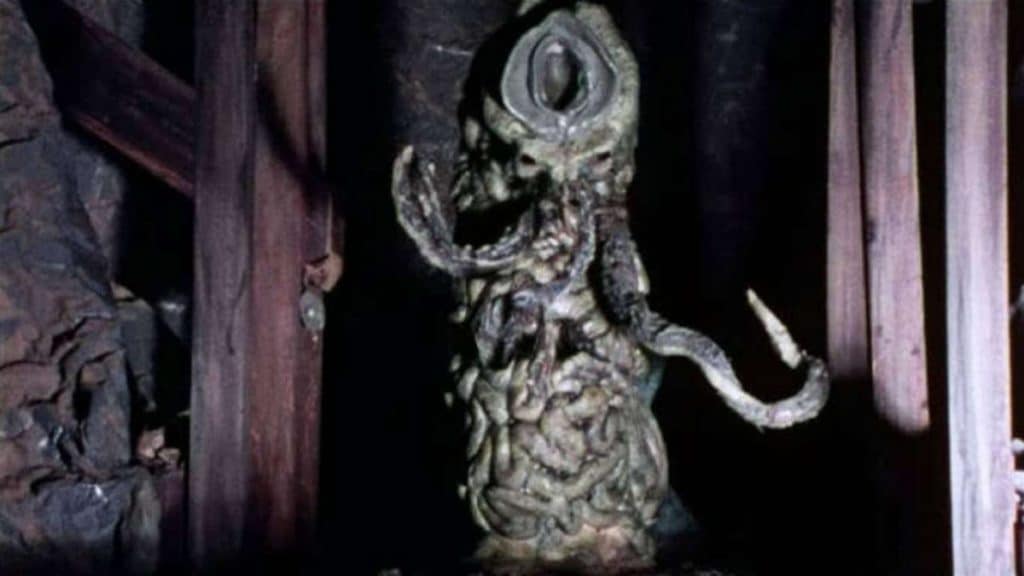KinoKultur is a thematic exploration of the queer, camp, weird, and radical releases Kino Lorber has to offer.
I’ll admit it. I believe in sea monsters. We know more about space than we do about the Earth’s watery, cavernous depths. I don’t know what’s out there! But what I do know is that the monsters in my mind, like all-natural monsters throughout history, embody all that is awesome and terrifying about Nature.
Deep Rising (1998) and The Strangeness (1985), two films recently released on home video by Kino Lorber, render such monsters on screen. They play on our deepest fears about the unknown natural world as well as our precarious place within it. Though opposites in terms of budget and financing, both of these pictures touch on similar themes and deliver similar results. Tangled together, these two tentacular tales teach us both about movie making and the deep anxieties lurking beneath the surface of our culture.
Deep Rising, helmed by Stephen Sommers (who would direct the biconic Mummy the very next year), was one of the last silver screen sea beastie films before the genre swam to the small screen and the warm, welcoming waters of the Sci-Fi (later Syfy) channel. It stars action legend Treat Williams as John Finnegan, captain of a small band of mercenaries hired to rob the luxury liner Argonautica. But Finnegan and his raiders aren’t the Argnautica’s only intruders.
When the ship has been brought to a standstill, it’s suddenly rammed from below. Taking advantage of the moment, cat burglar Trillian St. James (the divinely self-possessed Famke Janssen), attempts to rob the Argonautica’s safe, only to get swept into the action when everyone aboard realizes they’re been besieged by a terrifying creature from the deep.
It’s a peak American 1990s action film, boasting numerous explosions, jet skis, New Gilded Age hubris, uneasy racial politics, anxieties about computer technology, surveillance, and state-of-the-art digital effects by Industrial Light and Magic, which are well detailed on Kino’s release with several insightful commentary tracks and making-of interviews.
The interviews with creatives at Industrial Light and Magic like John Berton and Van Ling, while perhaps not the most gripping to watch, are richly informative about an era when CGI technology was on the brink of a major transformation as the digital age loomed large on the horizon.

At first, we only get ghostly flashes of the monstrosity lurking in the hull of the ship, building up classic suspense until we are finally confronted by a gargantuan creature, a heady CG mix of octopus, squid, and raw nightmare fuel, one whose tentacles terrify and abduct its prey, skinning and filleting them faster even than Martha Stewart.
To our 4K eyes, the CGI looks a little poorly rendered, the light hitting the creature’s “skin” with an uncanny flatness. Over time, the creature has become a spiritual cousin to the Argonautica, only holding on to the throne of innovation for a brief moment, ultimately foiled by natural causes—in this case, the passage of time and the advances in SFX technology that have come with it.
Long-buried by the passage of time, film company Code Red recently unearthed an indie horror (horror-comedy?), called The Strangeness which uses methods and motifs close to Deep Rising’s to present its beastie, though on a significantly smaller budget. Like all enjoyable creature features, The Strangeness begins with man’s attempt to dominate and profit from nature as a group of young adults are contracted by a mysterious patron to explore an abandoned gold mine. What they find lurking within will shake them to their core.
It’s a deliciously low-budget 80s picture complete with grainy film, schlocky teen slang, and a wonderful synth score. It’s the kind of indie video aesthetic we’ve felt the need to “improve” through the now-waning 1980s nostalgia wave most visible in Stranger Things and its peers.
Tentacles, and the creatures who possess them, are terrifying for how they disturb or challenge the natural order.
The brilliance of The Strangeness lies in director Melanie Anne Phillips’ ability to take tin foil sets and shots composed within the confined space of a garage and make them feel as though they’re cavernous expanses, the sort that only grows vaster the deeper into the earth as we go. Between Phillips’ skill and the limitations of the tools she was working with, there comes the enjoyable sense of watching a group of friends make a movie together on California weekends.
Phillips, who left Hollywood and went on to be a prominent figure in early transgender spaces on the Internet, expertly tricks her audience’s eyes with fog, flashlights, and flares. She works with her budget, rather than against it. This all leads to a gooey/goofy claymation creature designed by co-writer Christ Huntley and producer Mark Sawicki—a menacing, slightly vaginal, monstrosity of wiggling tentacles that foreshadows Kang and Kodos from The Simpsons. Sure, it looks a bit silly, but that’s part of what makes it fun—goofy as it is, it’s wonderfully real and handmade.
While The Strangeness’ dialogue may be awkward and does not always sound as if it was spoken by a human being, its story touches on classic creature feature themes like those found in Deep Rising. Both feature a delusional venture capitalist driving the plot towards disaster. Each, in its way, presents rugged but flawed masculinity driven by self-determination. Most importantly, they both remain ambiguous about human survival at the end of the film.

In Deep Rising, the monster is close to incidental, rising from subplot to plot as needed. There’s already an intrigue happening on the boat when the beastie collides with the ship. It isn’t prefaced by nuclear waste like kaiju movies nor is it made into an environmentalist metaphor.
The Strangeness, on the other hand, adds an extra layer of folklore, which cloaks the whole film with a deeper possible meaning. From the very start, the demon(s) living in the hills threaten the white man, specifically, as punishment for violating sacred Indigenous space. While the film doesn’t fully round out this postcolonial possibility, it adds an extra level of depth and meaning to a film that might otherwise feel superficial.
They (tentacles) are at once mouth, nose, hand, foot, and brain. They are, in a way, ultimate military-industrial terror—weaponized appendages.
Yet for all their differences in story and production, both Deep Rising and The Strangeness reveal something true and specific about tentacular tales. Tentacles, and the creatures who possess them, are terrifying for how they disturb or challenge the natural order. Tentacles confuse us. They are at once mouth, nose, hand, foot, and brain. They are, in a way, ultimate military-industrial terror—weaponized appendages.
Being so defiant of nature, tentacle tales also challenge technology. They disrupt the technology at the center of films, like the Argonautica. They especially challenge cinematic technology. To bring these category-defying creatures to life, filmmakers must be visually and technically creative. They typically belong to sea creatures, so when we see them in space or caves, such as in The Strangeness, they’re out-of-place and thus even more terrifying than they would be in their usual habitat. Be they attached to a Sea-GI beastie or a claymation cave horror, the presence of tentacles helps trigger fear and cue viewers to the uneasy fact that the natural order of things is neither ordered nor forgiving.